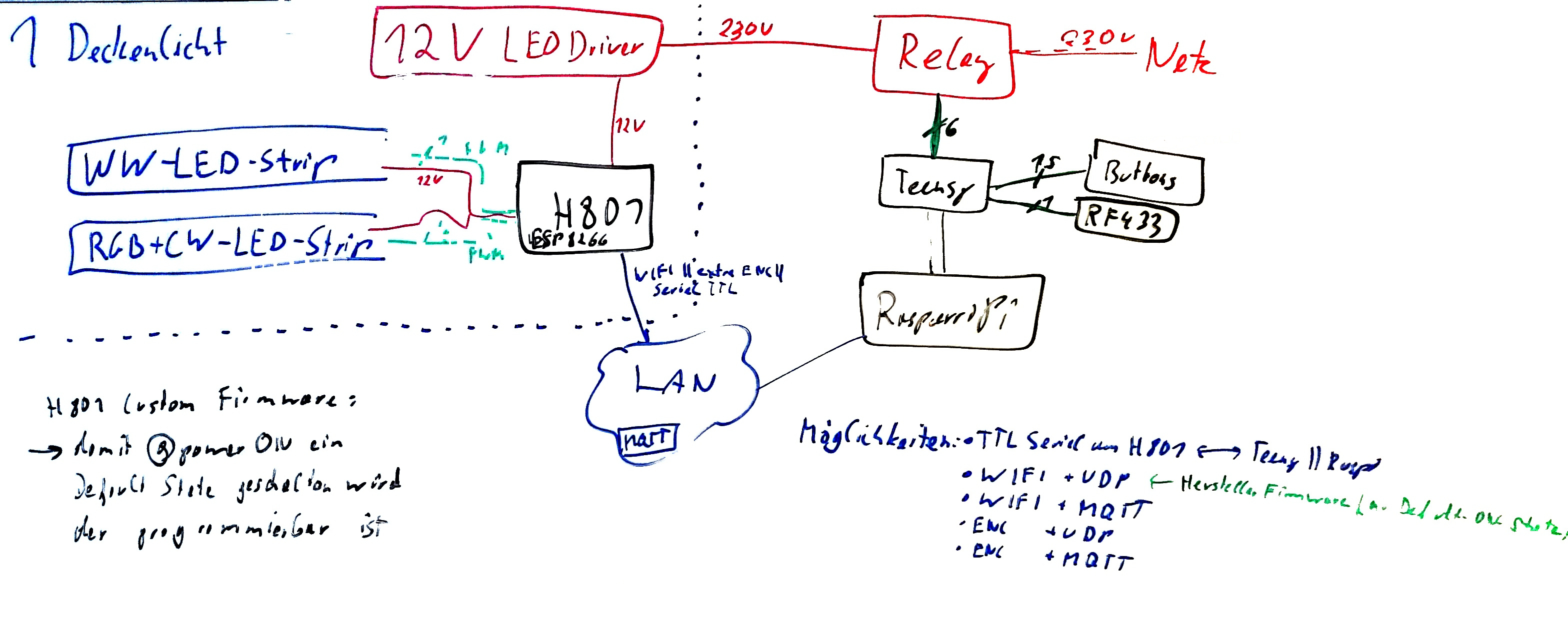—
— Make Ceiling Lights great again
[GitHubRepository](https://github.com/realraum/deckenlichtschalter)
State as of 2017-01-01 (he)
Original work by: [xro](doku.php?id=xro:xro)
* 6 Ceiling lights * 4 neon lights * 2 LED strip neon replacements * 2 5-wire 230V cables connect the lights to a self-made relay box * Each ceiling light * shares Earth and N * has it's separate L * relay box contains * 1x 4-channel opto-isolator relay 5V/230V , switchable with 3.3V IO, pull low to GND to switch * 1x 2-channel opto-isolator relay 5V/230V , switchable with 3.3V IO, pull low to GND to switch * Lasercut-Box with Light-Switches on wall * offers 6 2-way up/down switches * offers 3 push-buttons * –> 15 buttons * contains Teensy 3.0 µC (??) * contains RF433 transmitter * Teensy µC * reads 15 buttons * controls RF433 tx * has 6 unused gpio prepared to switch ceiling light directly * firmware takes rf433 cmds on ```/dev/ttyACM0``` * firmware reports buttons and takes gpio-to-set-states on ```/dev/ttyACM1``` * firmware also switches currently unconnected gpio directly * Relay-Box is connected to RaspberryPi1's GPIOS running as [licht.realraum.at](http://licht.realraum.at) * 5V to VDD * 3V3 to VCC * gpio4, gpio23, gpio18, gpio17, gpio22, gpio21 * RaspberryPi1
### Current Problems * if raspberryPi1 dies or has problems, light can not be switched * teensy Firmware logic for gpios LOW == ON needs to be changed * switching ceiling light power on/off is probably not as quick or nice-to-look-at as having planned [ESP8266 based H801](https://www.aliexpress.com/item/RGBWW-Strip-WiFi-Controller-1-Port-Control-200-Lights-Communicate-with-Android-Phone-Via-WLAN-to/32502007408.html) do it
Project FancyLights
Working on it: [xro](doku.php?id=xro:xro)
Plan is to replace all the power-sucking neon-ceiling-lights with LED strip lights. Furthermore white-light color-temperature should be adjustable. For party and effect purposes the ceiling lights should be dialable to any colour. To accomplish this, 2 LED strips will be installed in each ceiling light. 2.5m [RGB+CoolWhite](https://www.aliexpress.com/item/5m-4-color-in-1-Led-Chips-RGBW-RGBWW-5050-SMD-Led-Strip-DC12V-Waterproof-Non/32699614057.html) and 3m [WarmWhite LED Strip](https://www.aliexpress.com/item/50m-5m-roll-led-smd-waterproof-5050-60leds-m-dc12v-14-4w-m-flexible-led-strip/1562140605.html) for each light. They will be controled with a [ESP8266 based H801](https://www.aliexpress.com/item/RGBWW-Strip-WiFi-Controller-1-Port-Control-200-Lights-Communicate-with-Android-Phone-Via-WLAN-to/32502007408.html) for each light. Thus we can choose colour and white-colour-temp for each light.

Status: All materials bought, H801 deilvered, awaiting delivery of LEDs and power supplies
TODO
1. (done) verify H801 can be flashed with Sming firmware 1. (skipped) connect 2.5m RGB-CW and 3m WW LEDs to H801 and test with default firmware 2. (done) Measure power consumption of LED-Driver
2. (done)test WIFI reception of H801 in ceiling light without installing it permanently. Test various possibly installation locations to improve WIFI reception. e.g. put H801 outside light-metal-casing and under gypsum-ceiling plates or outside light-metal-casing and visible next to light.
Works Flawlessly :) 3. (done) reflash and write new trusted firmware for H801, so that it can be controlled via MQTT and remembers a default light-setting
4. (done) test in dry state
4.(done) test in indirect ceiling illumination configuration
4. (done) test in ceiling light enclosure
4. (done) Testinstall one in ceiling light
5. (almost done) change golightctrl so it can control H801 6. (1/6 done) install in ceiling lights 7. put CW-LEDs currently in one ceiling lights into MaSha WW-LEDs in all Ceiling lights as Simple-Light RGB+CW+WW-Fancy-Lights int all Ceiling lights 8. modify 20W RGB+WW Flodding Lights with H801 and indirectly illuminate ceiling
Project BasicLights
Plan: separate lights which work really really reliably
Working on it: [equinox](doku.php?id=equinox:equinox)
Status: WIP
TODO
1. (1/6 done) install Tanbaby LED Lights in Ceiling Lights 2. (presumably done) write firmware for Teensy2.0 3. (almost done) create enclosure with Teensy2.0 and buttons 4. install and connect power 5. interface with RasperryPi in a way that